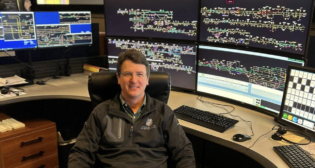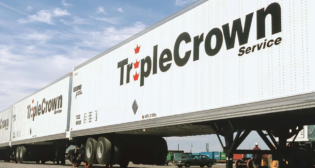
U.S. DOT Awards $320.6 Million for Rail Infrastructure and Safety Improvement Projects (Updated)
Written by Marybeth Luczak, Executive Editor
The Fiscal Year 2020 Consolidated Rail Infrastructure and Safety Improvements Program will fund projects that address safety at highway-rail grade crossings (and deter illegal trespassing), and expand, upgrade or rehabilitate railroad track, switches, and yard and station facilities to increase performance and service delivery.
The U.S. Department of Transportation (DOT) has announced that it is distributing $320.6 million to 50 projects that improve the safety, efficiency and reliability of freight rail and intercity passenger service in 29 states.
The funding is part of the Fiscal Year 2020 Consolidated Rail Infrastructure and Safety Improvements (CRISI) Program, which invests in projects that address safety at highway-rail grade crossings (and deter illegal trespassing), and expand, upgrade or rehabilitate railroad track, switches, and yard and station facilities to increase performance and service delivery.
Approximately $152 million will be invested in short line and regional railroad projects; about $40 million in highway-rail grade crossing improvement projects; and some $124 million in passenger rail projects. Of the 50 projects, 32 are rural-based. (To learn how CRISI Program investments and Rail Safety Week “go hand in hand,” click here for a Railway Age op-ed by Federal Railroad Administrator Ronald L. Batory.)
The grants will be administered by the Federal Railroad Administration (FRA), which issued a Notice of Funding Opportunity (NOFO) for the program in April.

The pandemic did not deter applicants this year, FRA Deputy Administrator Quintin Kendall said. There were 101. And with the addition of process improvements on the back end, evaluations took five months—from NOFO issuance to grant announcement. When the CRISI Program launched in 2017, it took 14 months for 49 applicants.
Many of the projects this year go beyond traditional infrastructure improvements, Kendall said, and incorporate safety education and high-tech components, for instance.
Among them:
• In Indiana, the Safer Railroad Crossings in Nappanee project has been awarded $1.4 million to not only improve seven at-grade crossings along a 2.5-mile rail corridor, but also develop a program to educate drivers about local safety issues related to crossings as well as outreach materials on suicide prevention. The corridor work will include the installation of constant warning time circuitry, roadway modifications and improved vertical geometry for low-ground clearance vehicle crossings.
• Texas A&M Engineering Experiment Station in College Station received $241,546 to implement drone technology and 3D mapping to study passive grade crossings in rural areas and determine if unsafe conditions exist for vehicle traffic.
• The Iowa Northern Railway Co. was awarded $5.4 million for education projects, which it will develop in partnership with the American Short Line and Regional Railroad Association. The grant will fund up to 30 virtual and in-person classes as part of a workforce development and safety program. Any Class II or III railroad employee will be able to participate, so they can meet FRA safety training requirements. The grant will also fund four mobile locomotive simulators for shared use among Class II and III railroads.
• The Pennsylvania Department of Transportation received $7.9 million to develop an onboard GPS sensor system for railcars, which will provide real-time car movement and condition/health information to shippers, car owners and railroads, so they can better manage consists, incidents and maintenance.
• The Wisconsin Department of Transportation was awarded $31.8 million for the Twin Cities-Milwaukee-Chicago Intercity Passenger Rail Service Project, which includes infrastructure improvements in Wisconsin and Minnesota on Canadian Pacific’s Soo Line serving Milwaukee, Wis., and Minneapolis/St. Paul, Minn. The project would “add the first state-supported intercity passenger rail frequency between the Twin Cities and Milwaukee to contribute to an eighth round-trip on the Hiawatha service between Milwaukee and Chicago. The Twin Cities are currently only served by Amtrak’s long-distance Empire Builder route.” The project will upgrade communication and signaling, extend rail sidings, improve at-grade crossings, extend yard lead track, and reconstruct and modify new turnouts and main line track.

Amtrak, which said it is “committed to the national network of long-distance, interregional trains,” received a $5.6 million grant to “stabilize and rehabilitate the route of the Amtrak Southwest Chief in Colorado and New Mexico.” Combined with $4.9 million in Amtrak federal funds set aside for this service and $1 million from the New Mexico Department of Transportation (NMDOT), a total of $11.5 million will be invested from Trinidad, Colo., to south of Lamy, N.Mex.
“This is the fifth federal grant for the route segment in these two states and Kansas,” Amtrak said. “There is still a significant need for component renewal and restoration of the line to bring it to a more robust condition. When these improvements and others are complete, it will remain a productive route for decades to come … Our past and current investments, from Kansas through Colorado and New Mexico, demonstrate our commitment to the Chief route and also preserve this segment for eventual inclusion in a north-south connection along the Front Range between Denver and Albuquerque, via Colorado Springs and Pueblo.”
Most of the trackage is owned by BNSF Railway, “which has moved its traffic to less mountainous routes,” Amtrak said. “The arid weather conditions and low freight tonnage since 2008 have allowed the right-of-way to remain in stable condition despite its advancing age. Amtrak, NMDOT and BNSF have identified critical areas where investment in the route infrastructure will improve its condition and enhance safety such that more efficient and productive maintenance dollars can be applied to it annually. Additional federal grant applications are expected to be sought.”
Project engineering and construction under this CRISI grant will be carried out by the BNSF Railway Engineering Department and the Rio Metro Regional Transportation District, the latter which manages the NMDOT infrastructure. Work is expected to begin in 2021 and carry into 2022.
New ties will be installed on a 31-mile section south of Raton Pass and another six-mile segment in New Mexico, more than 12 miles of bolted rail will be converted to welded rail between Lamy and where Rio Metro’s Rail Runner commuter rail traffic diverges to Santa Fe, and the decks of two bridges will be rebuilt, along with three grade crossings.
BNSF commissioned a geotechnical assessment to provide recommendations for the reduction of rockfall hazards at Raton Pass, Glorieta Pass and Shoemaker Canyon. The grant will fund additional stabilization and protection measures. BNSF’s 3.3% Raton Pass grade is only used by Amtrak trains and “is the steepest rail route in regular U.S. use. It is has been a National Historic Landmark since 1960 and is at an elevation of 7,834 feet,” Amtrak said.
For details on other FY 2020 CRISI Program projects recently reported in Railway Age, click here.
For a complete list of projects, click here.
The Fixing America’s Surface Transportation (FAST) Act authorized the CRISI Program from 2017-2020. While FAST is set to expire on Sept. 30., a one-year extension is expected, which would also extend the CRISI Program, Quintin Kendall said. (On Sept. 22, the House passed a bipartisan bill to continue government funding through Dec. 11 and avoid a government shutdown on Sept. 30, the last day in the 2020 fiscal year; the Senate is expected to approve the legislation.)
Since 2017, more than $1.2 billion has been awarded through the CRISI Program.



